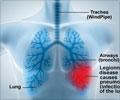A new method through which a disease pathway can be blocked, thereby providing protection from some of the most fatal infections, has been discovered by researchers.

What researchers at UTMB have found is a way to protect against what can be a fatal rickettsial infection. Their findings appear in the Proceedings of the National Academy of Sciences.
"Even more exciting, there is preliminary evidence that the experimental drug we have identified as being effective against rickettsiae may also be effective against viruses," said Dr. David Walker, chairman of the department of pathology at UTMB and executive director for the Center for Biodefense and Emerging Infectious Diseases.
Many scientists are concerned that temperature increases due to global climate change will lead to more widespread cases of rickettsioses, since the bacteria are spread by ticks, lice, fleas and chiggers that thrive in warmer climates. In addition, because the bacteria are easily transmitted, they could pose a bioterrorism threat, Walker said.
The diseases, which include Rocky Mountain spotted fever, can lead to death. In fact, a fatality rate as high as 32 percent has been reported in hospitalized patients with Mediterranean spotted fever.
"We believe that it is imperative that we find a way to control this disease," Walker said.
Advertisement
In humans and animals, the effects of this messenger are controlled by two types of receptors, one known as protein kinase A, or PKA, and a newly identified protein known as Epac. PKA and Epac can act in concert or in opposition to control many cell functions.
Advertisement
The mechanism by which this happens is being identified, and now a new candidate drug that inhibits Epac, known as ESI for Epac-specific inhibitor, has also been shown to protect normal mice from a fatal rickettsial infection. The researchers are currently designing a second-generation ESI that is more potent and is not toxic even at high doses. There are also indications from preliminary experiments that ESI protects animals against some lethal viral infections.
"This is an exciting development, given that our arsenal of treatments for these bacteria is quite limited," Walker said.
Source-Eurekalert









